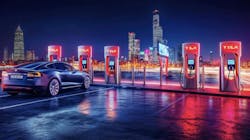Tesla Motors addressed a key concern of electric-car skeptics last week with a demonstration of a battery-swap capability that gets motorists back on the road in 90 seconds—vs. 30 minutes or more for about 200 miles worth of charge from the company's superchargers, as reported by Ashlee Vance in Bloomberg Businessweek.
In the demonstration at Tesla's Los Angeles design center, CEO Elon Musk asked, “What if people do want to switch out their battery pack if they only want to stop for a short period of time?” He added, “When you come to the Tesla Station, which shouldn't really be called the Tesla Supercharging Station—it should just be called the Tesla Station—you have the choice of the supercharger, which is and always will be free, or you have the choice of the battery pack swap, which is faster than you can fill a gas tank. So the only decision you need to make when you come to one of our Tesla stations is, do you prefer faster or free?
A live demonstration of the battery swap took place on a stage of the design center, accompanied by a film of a Tesla employee gassing up an Audi. “We searched LA for the fastest gas station which is 10 gallons per minute,” Musk said.
As the demonstration proceeded, Musk explained, “We have automated nut runners—these are the same nut runners that we use in the factory. They find the spot where the bolts are, and they automatically torque the bolts to the exact specification that each bolt needs, so it's torqued to the factory specification every time there is a battery pack swap.”
During the demonstration, two Tesla battery packs were swapped out in three minutes and 12 seconds; it took the employee with the Audi about four minutes and eight seconds to gas up and get back on the road. Further, the Tesla drivers had no need to leave their vehicles.
At the conclusion of the demonstration, Musk told his audience, “Our goal here was really to eliminate the objections that people have. Obviously for those of you here, you already believe in electric cars, and many or you drove here in a Model S, which is awesome. But what this is about is convincing the people that are skeptics–some people take a lot of convincing.”
He said that an electric car can actually be more convenient than a gasoline car, concluding, “Hopefully this is what convinces people finally that electric cars are the future.”
Vance in Businessweek noted that the first battery-swap stations will be installed between Los Angeles and San Francisco and between Boston and Washington.
Will Oremus in Slate, who had previously test-driven a Tesla S, added some additional details. Tesla will automatically bill customers $60 to $80 for a battery swap. In response to Musk's claim that the only decisions drivers pulling into the station will have to make is between fast and free, Oremus added, “In fact, though, if they opt for the battery swap, they’ll also have one more decision to make. They can either stop by the same Tesla station on their return trip and reinstall the original battery for the same price, pay to have their original battery shipped to another service center, or pay an as-yet-unspecified price to keep the new battery.”
The shipping option seems unnecessarily complex. This swap and pricing scheme by Tesla seems to assume that on a first swap, a vehicle's original battery will be swapped for a brand new one. As the system matures, it seems a given battery could be swapped out for one with a comparable recharging history, although that might complicate inventory problems at each station. It's also possible that a swap station's need to locate a particular vehicle's original battery might extend the swap time beyond the 90 seconds achieved at the LA design center.
Undoubtedly there will be issues to work out, but his seems a definite step in the right direction. Perhaps now Musk can turn his attention to the Hyperloop.
